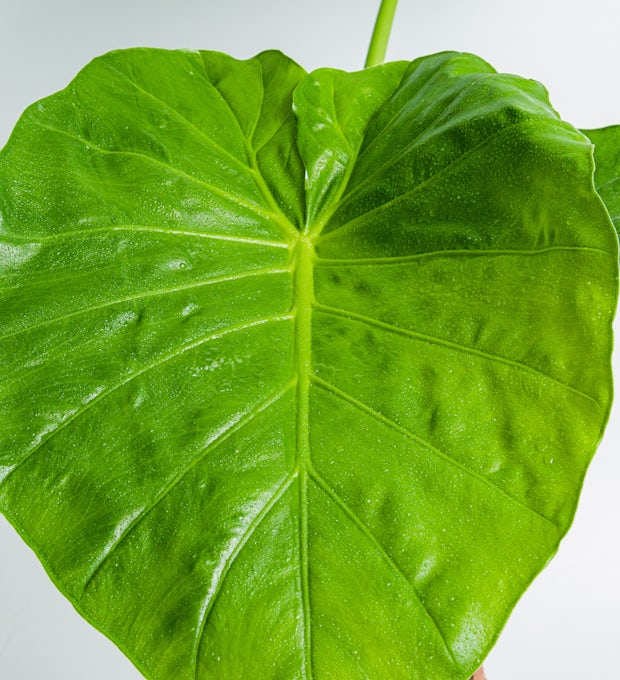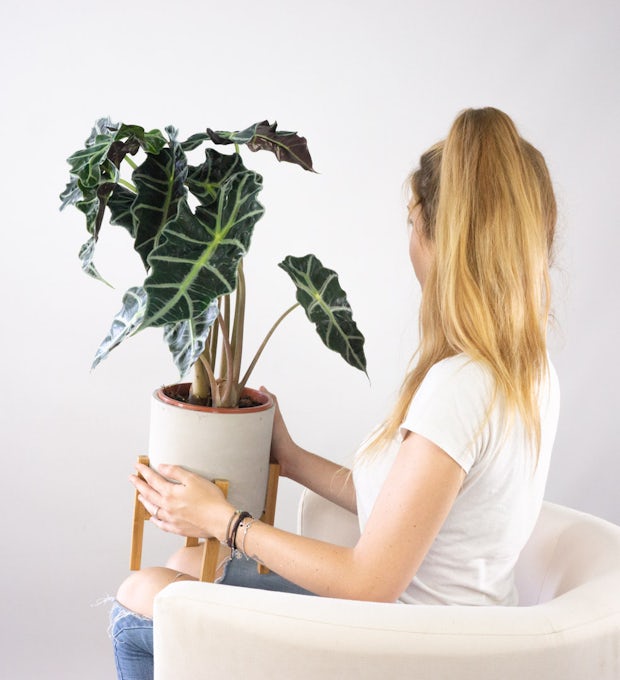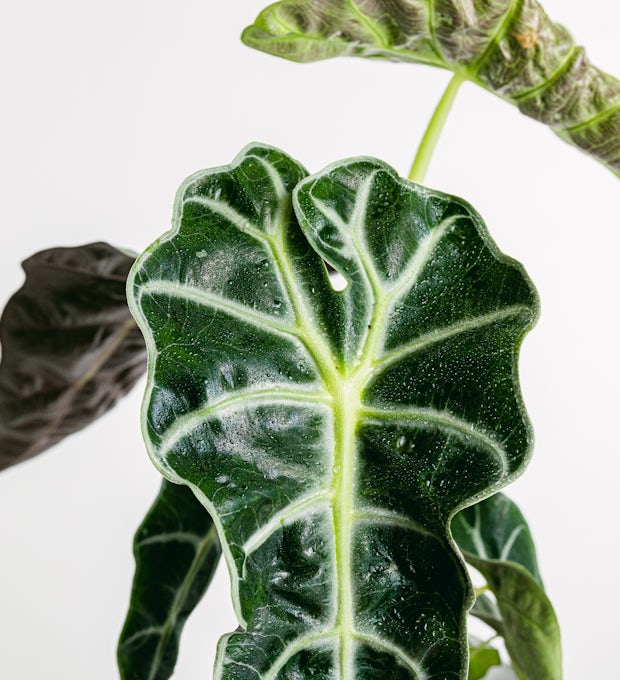Looking to add some exotic vibes to your indoor oasis? Well, let me introduce you to the African Mask Plant, also known as Alocasia.
With its lush green leaves and striking veins, this beauty is sure to steal the show in any space.
In my article, African Mask Plant: The Secrets to Thriving, Ill spill all the tea on how to care for this unique plant.
Get ready to unlock the secrets to successfully cultivating and nurturing this stunning plant. Lets dive in!
With its exotic, sculptural leaves, the African mask plant, also known as Alocasia amazonica, makes a stunning houseplant. This tropical native thrives indoors with proper care tailored to its preferences.
Follow these indoor growing tips to keep your African mask plant healthy and encourage lush, vibrant growth.
Provide Bright, Indirect Light
The African mask plant grows best in its native rainforest habitat with dappled sunlight filtering through the canopy Recreate these conditions at home by placing it near an east or west-facing window
South-facing light may be too intense causing leaf scorching. North-facing windows lack adequate brightness.
Signs your plant needs more light
-
Slow growth
-
Leggy stems
-
Fading leaf color
Rotate the pot weekly so all sides receive equal illumination. Wipe dust off leaves often to maximize light absorption.
Maintain High Humidity
With large, moisture-loving leaves, the African mask plant thrives in humid conditions of 60-80%. Low humidity causes drying, browning leaf edges.
Boost moisture around your plant with these tips:
-
Place on a pebble tray filled with water. The evaporating water increases localized humidity.
-
Mist leaves daily with a spray bottle. Focus on the undersides.
-
Use a humidifier to raise humidity in the whole room.
-
Grow in a terrarium or Wardian case to contain moisture. Open daily for air circulation.
Water Thoroughly When Soil is Partially Dry
The African mask plant needs consistently moist (but not soggy) soil. Allow the top inch or two to dry out before watering again.
Water until it drains freely from the bottom drainage holes. This ensures the entire root zone is hydrated.
Signs your plant needs water:
-
Soil feels dry when scratched
-
Leaves look limp or droopy
-
Leaf edges turn brown
Ensure the potting mix is well-draining to prevent root rot. Add perlite, orchid bark, or coconut coir to improve drainage.
Use a Well-Draining, Nutrient-Rich Soil
African mask plants thrive in loose, organic soil that retains some moisture while still draining well. Look for a mix containing:
-
Peat or coco coir to retain moisture
-
Perlite or bark chips to prevent compaction
-
Compost, worm castings, or charcoal to provide nutrients
Avoid regular potting soil, as this stays too wet. Re-pot in an aroid mix every 2-3 years as the old soil breaks down.
Fertilize Regularly During Growth Season
Feed your African mask plant every 2-4 weeks in spring through early fall to fuel growth. Use a balanced liquid fertilizer diluted to half strength.
Reduce feeding in winter when growth naturally slows. Flush the soil monthly to prevent mineral buildup.
Signs your plant is hungry:
-
Slow or stunted growth
-
Pale leaves
-
Leaf tips turning brown
-
Loss of lower leaves
Provide Warm Temperatures of 65-80°F
As a tropical plant, the African mask plant thrives in average room temperatures. Avoid placing it near cold drafty windows in winter.
Use a space heater or grow lights to maintain temperatures above 60°F. In summer, keep away from hot windows or AC vents blasting cold air.
Increase Air Circulation
Stagnant air encourages fungal and bacterial diseases. Use a small fan to gently blow air over your African mask plant daily.
Prune off any excessively crowded leaves to allow airflow within the canopy. Move the plant outdoors in summer for good air movement.
Prune Occasionally for a Fuller Shape
Remove any dead, damaged, or unsightly leaves at the base as needed to keep your plant full and shapely. Prune back overlong, leggy stems.
Don’t remove more than 20% of leaves at once. Sterilize pruners between cuts with isopropyl alcohol to avoid spreading disease.
Propagate Easily Through Division
As African mask plants mature, clumps may become overcrowded. Divide rootbound plants in early spring, using a sharp, sterile knife to cut sections with 3-5 leaves each.
Place them in an area with bright, indirect light and maintain high humidity around the plants, similar to the parent plant’s original growing conditions. Aftercare: Keep the soil consistently moist but not waterlogged. Maintain high humidity through misting, using a pebble tray, or placing a humidifier nearby.
Treat Mealybugs, Scale, and Other Pests Promptly
Check African mask plants frequently for signs of infestation like:
-
White cottony deposits on leaves or stems
-
Clusters of small bumps on leaves
-
Sticky residue on leaves
-
Distorted new growth
Isolate infested plants. Remove pests with cotton swabs dipped in alcohol. Apply neem oil or insecticidal soap sprays. Release beneficial insects if infestation is severe.
Protect From Temperature Extremes
While African mask plants flourish in average indoor temperatures, extreme highs or lows cause leaf damage.
In summer, provide shade if moving plants outdoors. Move pots away from hot sunny windows.
In winter, keep away from cold drafts. Move to the warmest room or use grow lights or a portable heater to maintain a temperature above 60°F.
Enjoy the Distinctive Foliage
With its dramatically shaped leaves in varying green hues, the African mask plant provides unique visual interest. Its large mature size makes a bold statement in any space.
Give this tropical beauty the warm, bright, and humid conditions it loves, and your African mask plant will reward you with lush, vibrant growth for years to come.
Troubleshooting African Mask Plant Issues
Here are quick tips to resolve the most common problems you may encounter while growing African mask plants:
Yellow leaves
- Overwatering – allow soil to dry out between waterings
- Underwatering – water when top few inches of soil are dry
- Insufficient nutrients – fertilize every 2-4 weeks
Brown leaf tips
- Low humidity – mist leaves daily, use a humidifier
- Irregular watering – water thoroughly then allow soil to partially dry
- Too much fertilizer – flush soil to remove buildup
Leaf edges turning brown
- Low humidity – use a pebble tray for added moisture
- Cold drafts – move plant away from drafty windows
Slow growth
- Insufficient light – place near east or west window
- Cool temperatures – maintain above 60°F
- Rootbound – repot in larger container
Leaves drooping
- Underwatering – check if soil is partly dry, water deeply
- Overwatering – allow soil to dry out before watering again
Mushy stems
- Overwatering – water less frequently, improve drainage
- Root rot – trim off rotten roots, repot in fresh mix
White spots on leaves
- Pest infestation – treat plant with neem oil or insecticidal soap
- Bacterial or fungal disease – improve air circulation, isolate plant
Webbing on leaves
- Spider mites – wipe leaves with damp cloth, apply neem oil spray
Sticky residue on plant
- Mealybug infestation – remove with cotton swab dipped in alcohol
Distorted new leaves
- Aphid infestation – spray plant with insecticidal soap solution
With the right care, your African mask plant will thrive for years! Correct any issues promptly by consulting this troubleshooting guide.

African Mask Plant Care
When caring for the African Mask Plant, its important to provide the right conditions and maintenance to ensure its optimal growth and health. Here are three key aspects to consider:




- Watering schedule: The African Mask Plant prefers to be kept consistently moist, but not soggy. In warmer months, water the plant every six to seven days, and adjust the frequency during its semi-dormant phase in fall or winter. Factors like pot size, soil type, location, and home environment can affect the watering needs, so its important to monitor the moisture level of the soil.
- Humidity requirements: Moderate to high humidity is crucial for the African Mask Plant. While the average houseplant enjoys around 50% humidity, this plant may suffer in areas with low humidity, like Tucson where it can be as low as 12%. Increase humidity by using saucers with water, misting the plant, using humidifiers, or using a humidity meter. Avoid letting the roots sit in water to prevent root rot.
- Soil mix: The African Mask Plant thrives in a well-draining soil mix. A recommended recipe is a combination of 1/3 coco chips, 1/3 pumice (perlite is fine too), and 1/3 potting soil. Adding charcoal can improve drainage, and incorporating organic compost when planting provides additional nutrients. Top dressing with worm compost and compost can also be beneficial.
African Mask Plant Traits
As a plant enthusiast, Ive come to appreciate the unique traits of the African Mask Plant. Native to the tropical rainforests of Southeast Asia, this plant thrives in its natural habitat of warm, humid environments.
With its striking growth patterns, the African Mask Plant can grow tall and spread out, becoming a low, wide floor plant. Alocasia Polly, a popular variety of the African Mask Plant, reaches a maximum size of 2 x 2 feet, while other Alocasias can grow as tall as 4-6 feet. These plants have a moderate growth rate, especially during the spring and summer months.
The deep green leaves with pronounced veins are a distinguishing feature of this plant, adding to its overall appeal.
How to Take Care of Your African Mask Plant
FAQ
Do African mask plants like to be misted?
What is wrong with my African mask plant?
Why are my African mask plant leaves turning brown?
